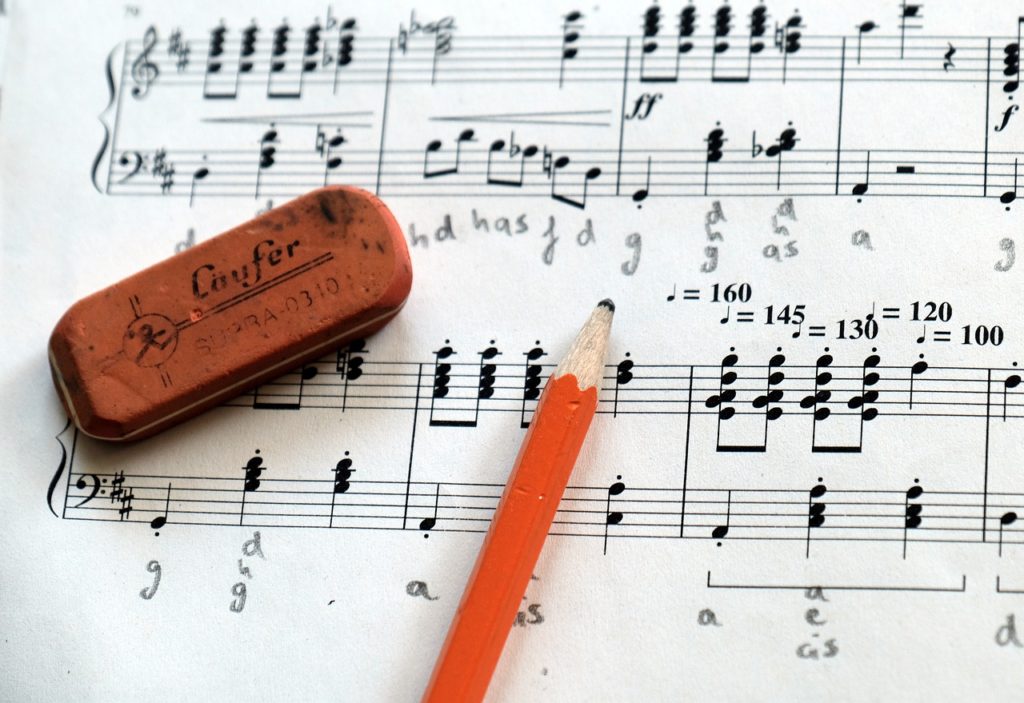Estimated reading time 4 minutes
Table of Contents
Introduction
“Can someone explain Roman Numeral Analysis in layman’s terms for me?” The Roman numerals you see in music might seem arcane. However, once you get a handle on them, they can really help your understanding of music. Read more to have the secrets of music theory explained in simple terms.
This article uses musical terms. For definitions, see the Glossary at the end of the post.

Explaining Roman Numeral Analysis in Layman's Terms #1: Scales and Chords
“Can someone explain Roman Numeral Analysis in layman’s terms for me?” Yes, but first we need to define some terms:
- We define a scale as a collection of notes that gets played melodically – one note after the other, not all at the same time.
- We define a chord as a cluster of notes that gets played together at the same time.
- In addition, we also call chords harmony because they are the notes that work in harmony together, i.e., they sound good as a unit.
Basically, each chord gets built on one of the notes of the scale:
- We call the notes of the scale the scale degrees.
- In the first example below, you can see that we have seven unique notes in the scale.
- Thus, we have one chord built on each of the seven scale degrees.
Mobile users: for best results reading the examples, tilt your screen 90o to the right.

Chords in the Key of C Major:
Explaining Roman Numeral Analysis in Layman's Terms #2: Chord Roots and Roman Numerals
“Can someone explain Roman Numeral Analysis in layman’s terms for me?” Okay, let’s talk about how you use Roman numerals to analyze the song’s chords.
We call the lowest note of each chord the root.
- The root note names the chord.
- So, the root of the C major chord is the note C.
- Thus, the chord is built on the first scale degree.
- We define a key as a collection of notes that we can use for making scales and chords.
When we analyze chords, we use Roman numerals to indicate what scale degrees a chord has been built upon.
Therefore, the chords in the key of C major will be:
- I = C major = root on the first scale degree
- ii = D minor = root on the second scale degree
- iii = E minor = root on the third scale degree
- IV = F major = root on the fourth scale degree
- V = G major = root on the fifth scale degree
- vi = A minor = root on the sixth scale degree
- viio = B diminished = root on the seventh scale degree
Explaining Roman Numeral Analysis in Layman's Terms #3: Numerals and Roman Numerals
“Can someone explain Roman Numeral Analysis in layman’s terms for me?” To do that, we should take a closer look at the numbers.
Notice that some Roman numerals have capital letters and others don’t:
- Upper case Roman numerals indicate major chords.
- Major chords sound bright and happy.
- Lower case Roman numerals indicate minor chords.
- Minor chords sound dark and sad.
- The lower case Roman numeral with a superscript “o” indicates a diminished chord.
- Diminished chords sound tense.
Also, notice that we have some normal numbers on the chart as well:
- These indicate the intervals between the notes of each chord.
- We define an interval as the distance between two notes.
For example, the V chord (G major on the chart above):
- The note G we call the root of the chord, which we use to name the chord.
- The note B we call the third, because it is three notes above G in the scale.
- The note D we call the fifth, because it is five notes above G in the scale.
Why use both Roman numerals and normal numbers?
- We use the Roman numerals to indicate on what note of the scale we’ve built a chord.
- We use our normal numbers to indicate the intervals used in each chord.

Final Thoughts on “Can Someone Explain Roman Numeral Analysis in Layman's Terms for Me?”

“Can someone explain Roman Numeral Analysis in layman’s terms for me?” Yes, let’s finish with what you use Roman Numeral Analysis for:
- Once you’ve used this chart to figure out which key your chords come from, you can use the scale chart to improvise a solo over the chords.
- Or you can compose a melody that works with the chords.
- Once you know which key your melody comes from, you can write supporting chords using the charts.
- You can use Roman numerals to help you to transpose (or change keys) for your song.
- You do this by keeping the relationships of the melodic and harmonic intervals the same while changing the notes to the new key.
- Also, you can analyze the chords from your favorite songs to find out how they work.
This will allow you to see patterns in music that you’ve never seen before.
In part 2 of the series, we’ll look at the difference between a root and a tonic. They have a simple but powerful distinction. Have fun writing!
Related posts:
- Changing Keys in Your Songwriting
- Do You Want Cool Chords for Your Song?
- Do I Need Talent to Write Music and Compose Lyrics?
- What is a Parallel Mode and How Does it Work?
© 2023 Geoffrey Keith
Join me for online or in-person lessons today!
Glossary
How to Employ Effective Equalization on Your Song
Do you want to know what the word equalization means? Do you want to know how to EQ your song mix? Equalization (EQ) is a potent means for creatively sculpting the sound of your song’s mix. However, if you want to be really good at applying EQ to a mix, you need to train your ears to hear what the mix needs. Keep reading “How to Employ Effective Equalization on Your Song” to improve your listening skills. Estimated reading time 3 minutes.
Read MoreImprovising vs Composing Music
Do you get confused about the ways improvisation and composition differ? Would you like to be better at both? Then, you’ve found the right post. Click to learn about improvising vs composing music. Estimated reading time 4 minutes.
Read MoreSinging Shape Notes Solfege Ionian Melodies
Want to be able to sing modes? I can help. You’ll see the Ionian mode more often than any other type of mode. It’s used extensively in pop, jazz, classical, and even folk music. In “Singing Shape Notes Solfege Ionian Melodies,” you’ll be singing the last mode we’ll look at in the modes series. Keep reading to learn more. Estimated reading time 2 minutes.
Read MoreQuestion, How Do I Get Better at Sight Singing?
“What purpose do accidentals serve in reading sheet music?” Sharps, flats, and naturals (collectively called accidentals) grew out of a problem that needed to be fixed in the mediaeval music notation. The music theorists of the time slapped their fix onto the preexisting notation system, and that fix is still with us to this day. However, having confused generations of budding musicians, the results of the fix leave a lot to be desired. Click to answer the question, “What purpose do accidentals serve in reading sheet music?” Estimated reading time 3 minutes.
Read More




